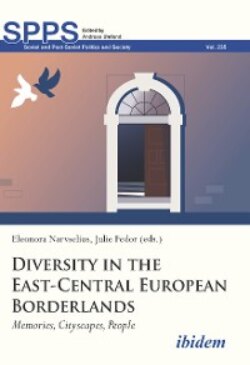Читать книгу Diversity in the East-Central European Borderlands - Группа авторов - Страница 22
На сайте Литреса книга снята с продажи.
Chernivtsi in Post-Soviet Ukraine
ОглавлениеFrom 1996 to 2001 the city population decreased from 264,000 to 240,000, consisting of almost 80% Ukrainians, over 11% Russians, just over 6% Romanians/Moldovans, and only 0.6% Poles and 0.6% Jews. The General Plan for Chernivtsi in 1993 suggests frameworks for saving the old city center, but shows industrial blocks along Synagogue Street (the old name has now been reinstated).
Several Soviet street names have been replaced, sometimes by the Austrian names, translated into Ukrainian. The main street is simply called Holovna.52 The former Jewish house provides space for a Jewish Museum and a Klezmer Orchestra. Most churches have reopened. The literary historian Petro Rychlo summarizes the cultural situation:
Slowly, only hesitantly, the historical memory awakens of the time when the city was part of the Central European cultural space. Sometimes, on the peeling walls, behind the Soviet plaster, German or Romanian texts appear—advertisements for companies that no longer exist, names of people who are long dead or scattered all over the world. The city can be read as an ancient palimpsest, whose secret signs testify to a spiritual world that has yet to be rediscovered (Rychlo 2004: 294–95).
Awareness of the uniqueness of Chernivtsi is growing. Historians, literary scholars, and architecture researchers devote much time to international co-operation, especially with Vienna, about the multi-ethnic cultural heritage of the city, including the Romanian heritage. Historical environments, buildings, streets, and squares have been upgraded. Prominent residents of the city—especially Ukrainian and Jewish ones—are honored with numerous plaques and statues. Old wall inscriptions, like Wolf Mandel and Isaac Eisikowicz, Pictor de firme, Fondat 1910, have been found and preserved. New bookstores and meeting places promote the memory of authors from the city. The small publishing house Meridian sertsia, which also runs a book café, has published many local authors. The Municipal Anatoly Dobryansky Library, established in 2006, continues the “Czernowitz spirit” in literature and culture.
When the former Metropolitan Palace was included in the UNESCO World Heritage list, the whole Habsburg city was defined as a “buffer zone,” essentially to be preserved. This also included most of the “lower town” including Synagogue Street. Among the restored buildings are the Mordko and Taube Korn Synagogue, the Chewra Tehilim Synagogue (now a Baptist church) and Türkenbrunnen.
